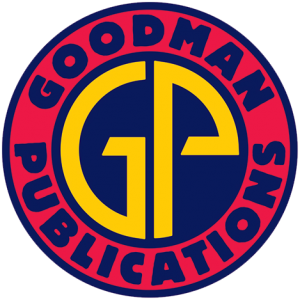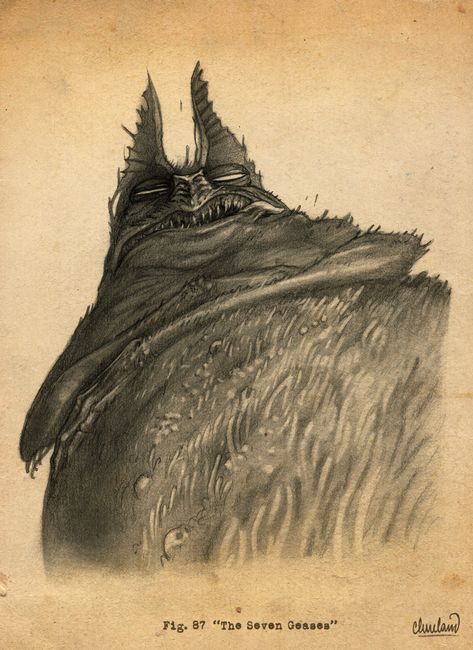Short Sorcery: Clark Ashton Smith’s “The Seven Geases”
by Bill Ward
Hearken back to one fine day in prehistoric Hyperborea as the proud hunting party of Lord Ralibar Vooz, “high magistrate of Commoriom and third cousin to King Homquat,” scours the flanks of Mount Voormithadreth in the Eiglophian Range for rare quarry. Lesser sportsman might content themselves with the sabertooth cats that stalk the jungle girding the great volcanoes of the Eiglophians, or perhaps the runty dinosauria that are the last echo of a forgotten age, but not so Lord Vooz. For he and his retainers have come to hunt the namesake of the mountain Voormithadreth itself, the Voormis, subhuman creatures cousin to man and beast alike. Only in such a cunning prey can the Lord and his heavily-armed lackeys find a challenge befitting the status and station of the impressively grand Ralibar Vooz.
Thus begins “The Seven Geases,” a sword-and-sorcery tale from Clark Ashton Smith with a plot more akin to a parable than an adventure story, and with a punchline instead of a climax. Like most of Smith’s early Hyperborean tales, it is comedic – in this case a black comedy written with ironic detachment in which Smith’s powers of invention are deployed to near-absurdist effect.
Vooz and his twenty-six men rattle through the high mountain passes equipped in Hyperborean age state-of-the art; crossbows, polearms, dinosaur-leather jerkins, “throwing-darts, two-handed simitars, maces, bodkins and saw-toothed axes.” Encased in a fine shirt of copper rings, carrying a spiked buckler of bronze and mammoth hide, Vooz is a larger-than-life powerhouse “of huge stature and strength, his shoulders and baldric … hung with a whole arsenal of weaponries.” When his men, unnerved as they ascend higher up the flanks of the sacred mountain, recount the dark legends of the origins of their prey and the mysterious underworld of Voormithadreth, said to be the abode of the foul elder god Tsathoggua and other depravities, Vooz only scoffs. This metal-clad King’s cousin has a “thoroughly modern disdain of the supernatural” and cheerfully dismisses any claims of gods with forceful blasphemy.
But Vooz soon meets the nemesis to his hubris in the form of a withered old sorcerer living in a mountain hovel. “[B]ut it was not his nature to abandon any enterprise no matter how trivial, without reaching the set goal.” With tenacious – and ultimately ironic – determination Vooz wins through the old wizard’s illusory protections, losing his retainers in the process. Ezdagor the hermit magician is furious at the interruption of a delicate spellmaking and lays a doom upon the Lord. Vooz blusters arrogantly of his position and power, but the old hermit responds: “I care not if you are the magistrate of all swinedom or a cousin to the king of dogs. In retribution for the charm you have shattered, the business you have undone by this oafish trespass, I shall put upon you a most dire and calamitous and bitter geas.”
The compulsion or curse of the geas is a magical command that Vooz is powerless to deny. He is bidden to disarm himself and win his way barehanded through the warrens of the Voormis, there to enter into the ancient dark below the mountain and present himself as a sacrifice to the toad god Tsathoggua. With Ezdagor’s Archaeopteryx-like familiar Raphtotis as both goad and guide, Vooz sets off to do exactly as he is commanded, equally horrified by the act itself and by his inability to stop himself from performing it.
But vile, bat-furred, toad-bloated Tsathoggua, lazing in a cavern littered with the carcasses of past victims, politely declines to eat Vooz when he presents himself for sacrifice. The old one has already had lunch! What would feature as the febrile sanity-shattering climax of a Lovecraft story is here played as a bit of a joke, and it’s also just the first of the seven geases laid upon Vooz – for Tsathoggua passes the prince along with another geas, another compulsion to offer himself up as food.
And so it goes, from oddity to oddity, from horror to horror, Vooz is sent circulating around the vast below-ground world in a cycle of humiliating rejection. The spider-god has no time to waste on him, forever spinning bridges across a vast underworld chasm. The darksome sorcerer on the high seat surrounded by walls of hungry stone faces, doesn’t think Vooz an adequate morsel for his familiars. The erudite reptile men, profoundly scientific, doubt that the study of Vooz can teach them anything they don’t already know about his kind. In a delicious juxtaposition with Vooz’s sneering contempt for the Voormis, he finds himself the subject of a brief, impromptu lecture on comparative anatomy alongside a preserved Voormis cadaver – in the eyes of all of these alien things, the third cousin to the Commorium King is just another surface animal to be dissected and analyzed.
The repetition that may have caused “The Seven Geases” to initially be rejected for Weird Tales (Wright apparently said it was just one geas after another!) is fundamental to the nature of this kind of story, and gives it a bit of the feel of something surviving from an older, oral storytelling tradition. But repetition is also a tool of comedy, and “The Seven Geases” builds, in scene-after-scene, not so much a dramatic tension as an ironic one – we readers, of course, already know the structure from the title of the story itself and, as each story-beat gets more fantastical, as each scene takes Vooz down a further notch or two, our amusement at his plight increases.
“The Seven Geases” isn’t a comeuppance tale, though, and Vooz isn’t really there to be hated. Unsympathetic, yes. But to hate him would be to give him more stature as an entity and even as an element in his own story; to make him important. Smith very subtly treads a thin line between conveying the horror of Vooz’s cursed condition and his own irrelevance in a subsurface world of nightmares that regard him as a curious bit of flotsam. His journey is expansive, the negative space of the underground world is one Smith paints as a limitless and multiform vastness in contrast to the above-ground opening of the story. When Vooz had literally been climbing the cliffs of the tallest mountain in the land, in a wide-open world of sky and jungle, the focus was tightly on him, on the ground, on the hunt. Only when he enters the dark – and when a geas removes him of any purpose of his own – does he become small and the world big.
This diminishment as he descends sees Vooz go from being rejected as inconvenient, to despised as malformed, grotesque, abhorrent, and unnatural. The further down he goes, with each bizarrely polite encounter, Vooz becomes a lesser thing until he is sent to Abhoth, a primordial ooze of filth and pestilence, an animate pool of excrement, a jelly forever spawning and consuming its own mutant progeny. It doesn’t want to eat him either, and rejects him thusly: “You are quite alien to my experience; and I do not care to endanger my digestion with untried articles of diet.”
Abhoth (part of the shared Lovecraftian pantheon, along with Tsathoggua) places the seventh geas on Vooz – seek the rumored nightmare landscape of the Outer World! The irony of his last doom of course is that it is Vooz’s salvation, his heart’s desire. He is allowed rest and food for the journey. So satisfying is the joke that I think most readers naturally imagine it to its conclusion – Vooz, stumbling from some cave in the side of the mountain, sucking clean air into his lungs, changed utterly by his experience. But Smith’s real punchline is far darker.
Pursued by the hungry spawn of Abhoth, Vooz ascends the catacombs until he comes once more to the realm of the spider-god, the silk-strand bridges running across a black chasm. He runs across, the strand breaks, and he falls into blackness as the story ends with the remark that such a “contingency … had not been provided against by the terms of the seventh geas.”
Vooz pays the price for his blasphemous hubris, for elevating himself and the tools and ways of man above that of the elder forces lurking in the dark spaces of the world. And while his death – diminishing to a speck of nothing as he plunges through an infinite field of black – is fitting, it’s his suffering that is telling. Denying the gods and the supernatural, he comes face to face with those very things and he, in turn, is himself denied. It isn’t just his self-importance they take away, they recognize neither dignity or even utility in the human form itself – he isn’t even worth eating. The theme of human insignificance is as strong here as it is in any Lovecraftian horror, but instead of a cosmos oppressive and uncaring in its limitlessness, it is the deep world of the underground, a dark obscure sea of old-time and pre-human intelligence, that renders our mortal protagonist ridiculous and small, and his death a whim of circumstance. Ultimately, perhaps, it was the sin of the denial of the wondrous while inhabiting a very world of wonder that placed an inexorable doom upon the brow of Lord Ralibar Vooz long before a mountain hermit cursed him with the first of seven geases.






